| Srl | Item |
| 1 |
ID:
135303
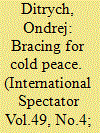

|
|
|
|
|
| Summary/Abstract |
The crisis in Ukraine has turned the tables of the post-Cold War relationship between the United States and Russia. The ongoing transformation can result in a number of outcomes, which can be conceived in terms of scenarios of normalisation, escalation and ‘cold peace’ – the latter two scenarios being much more probable than the first. NATO ought to shore up its defences in Central and Eastern Europe while Washington and its allies engage in a comprehensive political strategy of ‘new containment’. This means combining political and economic stabilisation of the transatlantic area with credible offers of benefits to partners in the East and pragmatic relations with Russia which are neither instrumentalised (as was the case with the ‘reset’) nor naïvely conceived as a ‘partnership’.
|
|
|
|
|
|
|
|
|
|
|
|
|
|
|
|
| 2 |
ID:
189660
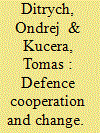

|
|
|
|
|
| Summary/Abstract |
This article situates recent initiatives to deepen security and defence cooperation in the European Union in the historical perspective. It proposes a model of constitutive relationship between the process of change in a security community and the formation of a transnational defence industry community of practice which yields positive feedback (‘productive returns’) to the security community as a broader assemblage within which it was constituted. This model is applied to the paradigmatic case of European security community that formed after the World War II (WWII). The analysis shows that the key driver for defence integration traced by means of social network analysis (SNA) in this case was economic rather than political, and for an extended period of time it developed without formal institutions. The productive return of the ‘defence industry machine’ as a distinct community of practice that was constituted through the integration process consisted in the sense of deeper belonging and a shared sense of working well together in a traditionally highly nationalised defence milieu.
|
|
|
|
|
|
|
|
|
|
|
|
|
|
|
|
| 3 |
ID:
121823
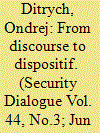

|
|
|
|
|
| Publication |
2013.
|
| Summary/Abstract |
This article is a historical study of how states have articulated statements about terrorism since the 1930s; under what conditions these statements have been articulated; and what effects the discourses made up of these statements have had on global politics. This includes the constitutive role of the present discourse on what is posited as a terrorism dispositif. The inquiry is inspired by Foucault's historical method, and comprises the descriptive archaeological analytic focused on the order of the discourse (including basic discourses in which the terrorist subject is constituted) and the genealogical power analysis of external conditions of emergence and variation of discursive series, whose treatment benefits also from Carl Schmitt's concept of the nomos.
|
|
|
|
|
|
|
|
|
|
|
|
|
|
|
|
| 4 |
ID:
163163
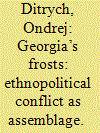

|
|
|
|
|
| Summary/Abstract |
This article is a reinterpretation of ‘frozen conflicts’ as assemblages binding together and strategically orienting a variety of components from both human and nonhuman estates at various scales in order to make a move toward ‘unfreezing’ their research. It then demonstrates how this perspective may be employed in the case of the ethnopolitical conflict in Georgia. The resulting analysis points to several important processes that animate the constant pulsation of the conflict field even when arms are calm and contribute to the dynamic and becoming nature of the conflict and its dynamic (re-)assembling. It illuminates how the visibility function of the assemblage operates and endows with meaning the structure of relations in the conflict field. It traces how the bricolage of Georgian social association transformed over time, notably under Saakashvili, and how it has also been a key element of statebuilding practice in the separatist entities. The analysis moreover demonstrates how the actual instantiations of collective violence form but a fraction of that which takes place in the conflict field, from other forms of political and criminal violence to regime change, state (un-)making through processes of contraction or extension of heterogenous, ‘hybrid’ governscapes including some distinctly virtual ones but betraying real political effects. Finally, it expounds how the ethnopolitical conflict assemblage affixes together a variety of agency from human agents to institutions from local to state governments or the international conflict resolution apparatus in addition to the material (nonhuman) actants enrolled in the translation networks populating the conflict field.
|
|
|
|
|
|
|
|
|
|
|
|
|
|
|
|
| 5 |
ID:
084803
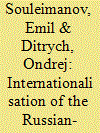

|
|
|
|
|
| Publication |
2008.
|
| Summary/Abstract |
The article provides a critical reading of various related discourses, depicting the political motives behind the conflict in Chechnya as a battlefield of the global jihad. These narratives have sought to present the involvement of external Islamist groups as a major factor in the conflict, and to portray many of the main groups within Chechnya as subscribing to a jihadist ideology. The authors suggest an alternative narrative focusing on the significance of the blood feud in the societies of the North Caucasus. It is argued that it is necessary to differentiate between the radicalisation of the resistance as such and the strengthening of the ideology of jihad. It is concluded that the resistance currently assumes a supranational character, yet one which is delimited regionally rather than globally.
|
|
|
|
|
|
|
|
|
|
|
|
|
|
|
|
| 6 |
ID:
078064
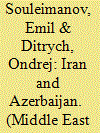

|
|
|
|
|
| Publication |
2007.
|
| Summary/Abstract |
After the fall of the USSR in 1991, there appeared a new player in the South Caucasus whose role in this region used to be of great importance. Iran, once forced to retreat as a consequence of the Russian army's march to the south, has after more than 160 years received an opportunity to conduct an autonomous policy in the region again and attempt - if the geopolitical constellation permits - to realize its ancient strategic aims. Whether Iran will be successful in its attempt to restore its former influence in the South Caucasus will depend on Azerbaijan and - to a greater extent than conventionally assumed - on oil production and transportation issues. It is therefore suggested that Iranian-Azerbaijani relations have been crucial in the formation of the Islamic Republic's foreign-policy agenda in the region and will remain so in the future.
Another variable to be taken into account is the wider international context in which Iran finds itself today, particularly in terms of its relationship with the great powers of Russia, China and the West. Iran's policy may from this perspective be seen as a piece in the mosaic of a Eurasian "grand strategy" of local powers to limit the U.S. presence in the wider region of Central Eurasia. This article is an attempt to analyse Tehran's complex policies vis-à-vis its northwestern neighbor, focusing on the context of interstate relations
|
|
|
|
|
|
|
|
|
|
|
|
|
|
|
|